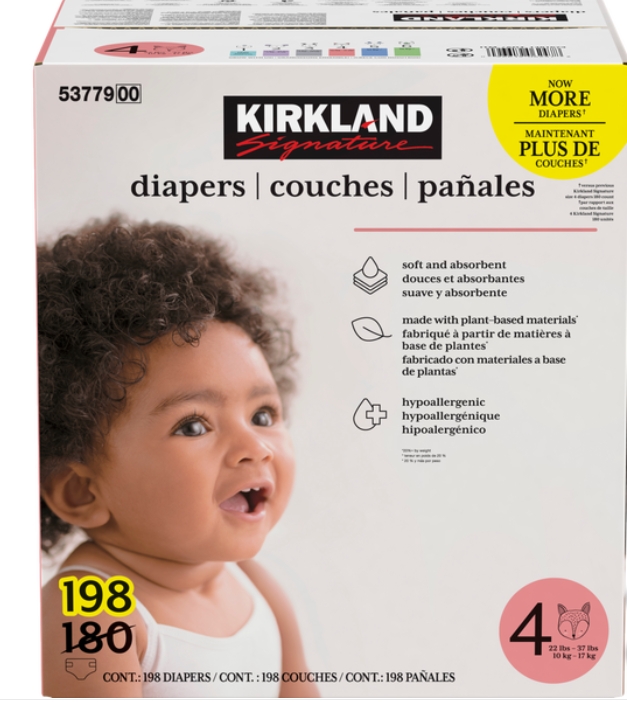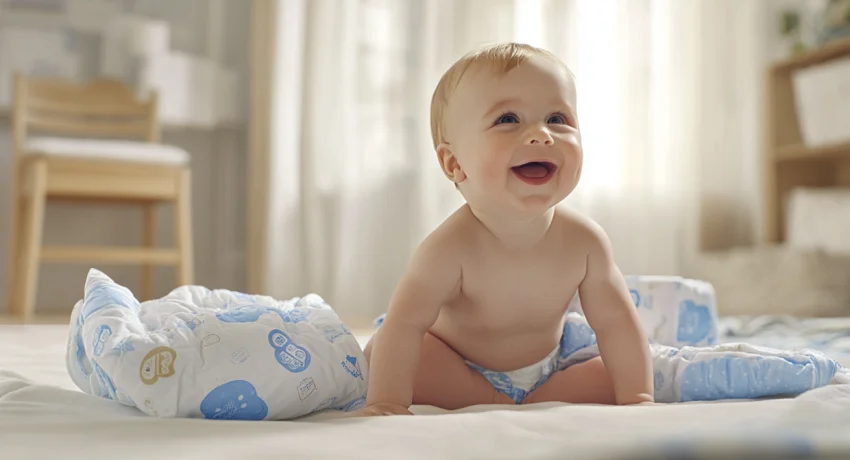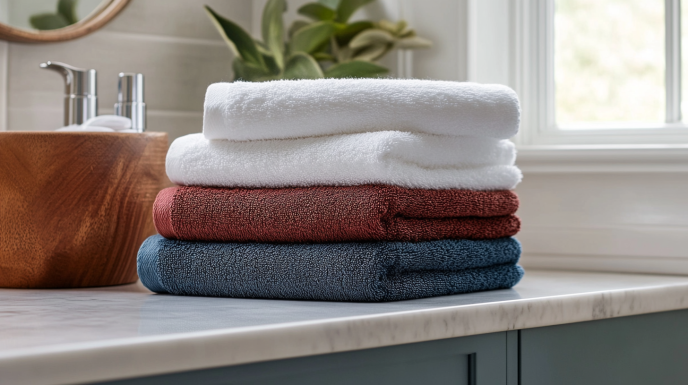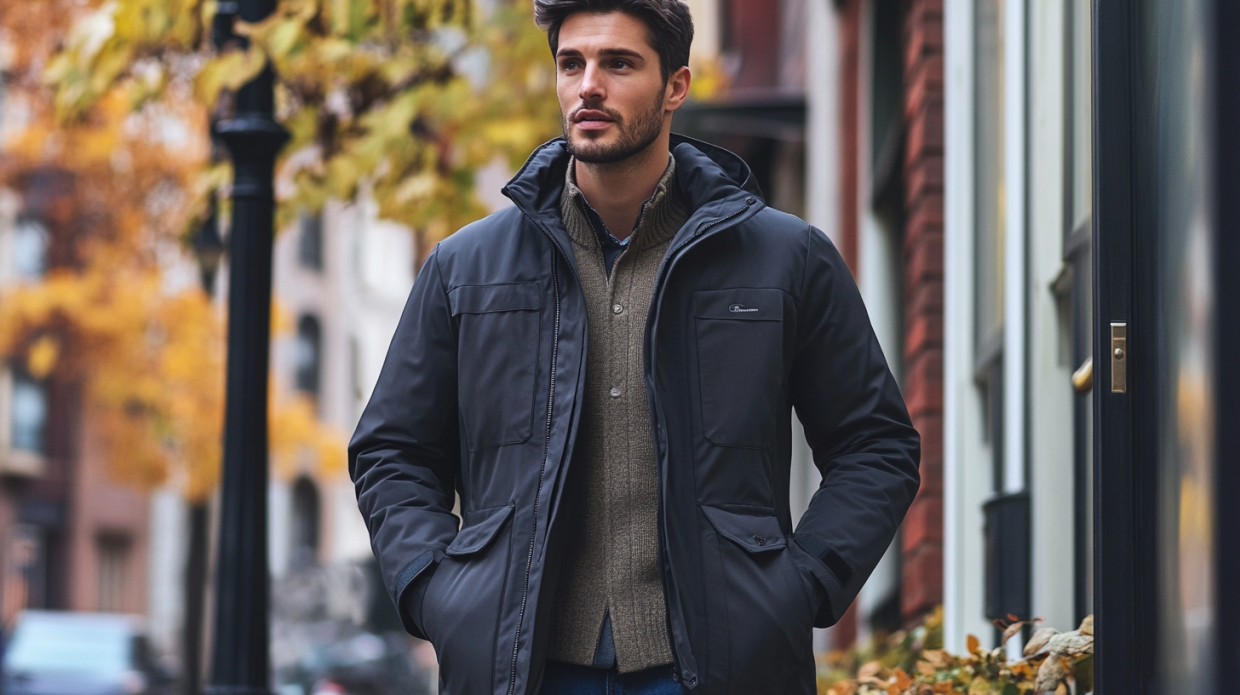
Kirkland Signature Diapers, Size 4, 198 ct
- Soft, breathable outer cover
- Soft and absorbent
- Made with plant based materials* (*at least 23% by weight)
- Wetness indicator
- Next size up indicator
- 22 lbs – 37 lbs
Navigating the World of Toddler Diapers with Costco’s Popular Brand
As a parent navigating the toddler years, finding the perfect diaper becomes something of an obsession. Between blowouts, overnight leaks, and active little ones who refuse to stay still during changes, having a reliable diaper is worth its weight in gold—or should I say, worth its weight in uninterrupted sleep? Today, I’m diving deep into everything you need to know about Kirkland Diapers Size 4, the workhorse of the diaper world that has saved many parents’ sanity (and many outfits from unfortunate stains).
When my son hit that growth spurt around 18 months, we found ourselves in the market for a new diaper solution. After trying what felt like every brand on the market, we stumbled upon Kirkland’s offering during our weekly Costco run. Three years and two kids later, I’m sharing everything I’ve learned about these budget-friendly lifesavers.
Understanding the Basics: Weight Range and Sizing
Let’s start with the fundamentals. Kirkland Diapers Size 4 are designed for babies and toddlers weighing between 22 and 37 pounds. This typically covers children from around 16-18 months to 2.5 years old, though every child grows at their own pace. If your little one is reaching the upper end of this weight range but the diapers still fit comfortably, there’s no rush to size up.
What I appreciate about Kirkland’s sizing is the slight overlap between ranges. This gives parents some flexibility during that awkward transition period when your child might be technically ready for Size 5 but still fits comfortably in Size 4. The most important factor in choosing the right diaper size isn’t just weight—it’s how the diaper fits your individual child.
I discovered this firsthand when my daughter, despite being within the Size 3 weight range, kept experiencing leaks until we sized up to 4. Her chunky thighs needed the extra room, while my son stayed in Size 4 longer because of his slimmer build. The stretchy side panels (which we’ll discuss more later) help accommodate different body shapes within the same weight class.
Value Breakdown: Cost Analysis of Kirkland Diapers Size 4
Let’s talk money, because parenthood is expensive enough without overpaying for diapers. A box of Kirkland Diapers Size 4 typically contains 180 diapers and costs around $42.99 at most Costco warehouses (prices may vary slightly by location). This breaks down to approximately 24 cents per diaper—significantly less than premium brands like Pampers or Huggies, which often cost 30-40 cents per diaper.
For context, the average toddler in Size 4 diapers goes through about 5-6 diapers per day. At that rate, a box of Kirkland diapers lasts about a month, costing around $43 per month compared to $60-70 for premium brands. That’s a savings of up to $324 per year—enough to cover a nice birthday present or contribute to the college fund.
When Costco runs their periodic $8-off promotions, the value becomes even more impressive. I’ve developed a sixth sense for these sales and always stock up, sometimes buying two boxes at once. My husband used to laugh at our “diaper stockpile” until we moved to a new city and discovered the nearest Costco was 45 minutes away. Then he appreciated my strategic hoarding.
Composition and Materials: What’s Actually in These Diapers?
Parents today are rightfully concerned about what materials contact their baby’s skin 24/7. Kirkland Diapers Size 4 are made with a blend of polypropylene, polyethylene, and absorbent materials (primarily wood pulp and super-absorbent polymer). The inner liner that touches baby’s skin is soft, cloth-like, and designed to wick moisture away from the skin.
One of the most frequently asked questions is whether Kirkland Diapers Size 4 are hypoallergenic. The short answer is yes—they’re made without natural rubber latex, elemental chlorine, and harsh chemicals. They’re also fragrance-free, which is excellent news for babies with sensitive skin or parents concerned about unnecessary additives.
My daughter has eczema, and we’ve found that Kirkland diapers don’t trigger flare-ups the way some other brands have. That said, every child’s skin is different, and what works for one baby may not work for another. If your little one has particularly sensitive skin, it might be worth trying a small package before committing to the warehouse-sized box.
Design Features: The Details That Matter
Diaper technology has come a long way since our parents’ generation, and Kirkland hasn’t skimped on the features that make modern diapers so effective. Here’s what you can expect from Kirkland Diapers Size 4:
Wetness Indicator
Yes, Kirkland Diapers Size 4 come equipped with a wetness indicator—that yellow line that turns blue when wet. While this feature becomes less crucial as toddlers get older and their wet diapers become more obvious (both in appearance and, ahem, aroma), it’s still handy for quick checks during busy days.
I’ve found the indicator to be reliable, though not quite as sensitive as some premium brands. It typically changes color after a substantial pee rather than at the first drop of moisture. For most parents of toddlers, this is actually preferable—you don’t need to change after every tiny trickle.
Stretchy Tabs and Waistband
The elastic tabs on Kirkland Size 4 diapers provide an adjustable, secure fit that accommodates different body shapes and active movement. The stretchy waistband in the back helps contain messes while allowing freedom of movement—crucial for toddlers who refuse to lie still for diaper changes and immediately bolt into a sprint or climbing expedition.
I particularly appreciate how the tabs don’t lose their stickiness when you need to adjust them, unlike some other brands where you get one chance to position the diaper correctly. When you’re dealing with a squirmy toddler who’s suddenly discovered their diaper-removal skills, this feature is invaluable.
Absorbency Core
The core of Kirkland Diapers Size 4 contains multiple layers of absorbent material designed to lock away moisture and keep baby’s skin dry. The diaper features channels that distribute wetness evenly throughout the core rather than concentrating it in one spot, which helps prevent sagging and leakage.
In practical terms, this means the diaper can typically handle several hours of wear without becoming uncomfortably heavy or prone to leaks. For most toddlers, this translates to 3-4 hours of protection during active daytime use.
Overnight Performance: The True Test of Any Diaper
Let’s be honest—the real measure of a diaper’s worth is how it performs during those crucial 10-12 hours of nighttime sleep (or what parents of toddlers call “theoretical sleep”). Kirkland Diapers Size 4 excel in overnight protection, often eliminating the need for specialized overnight diapers for many children.
The absorbent core can handle significant volume without leaking, though there are limitations. For heavy wetters or children who sleep on their stomachs (which concentrates moisture in the front of the diaper), you might occasionally experience leaks. In these cases, sizing up for nighttime or using a specialized overnight diaper might be necessary.
My son was a side sleeper who didn’t drink much before bed, and Kirkland Size 4 diapers were perfect for him overnight. My daughter, however, insists on sleeping face-down while somehow consuming what seems like gallons of water right before bedtime. For her, we used Kirkland Size 4 during the day but sized up to Size 5 for overnight until she was fully in the Size 5 weight range.
Leak Protection: Real-World Performance
Beyond overnight wear, how do Kirkland Diapers Size 4 handle the various challenges of toddler life? From my experience and conversations with countless other parents, they perform admirably in most situations:
- Regular daily wear: Excellent absorbency for 3-4 hours of typical activity
- Naptime: Generally reliable for 2-3 hour naps without leaks
- Car rides: The snug fit prevents leaks during long periods of sitting
- Active play: The stretchy sides accommodate movement while maintaining fit
- Blowouts: The back waistband and leg cuffs contain most messes effectively
That said, no diaper is completely infallible. During periods of teething (when stools are often looser) or when your child is between sizes, you might experience occasional leaks. The key is finding the right fit—make sure the diaper sits at the natural waistline, the leg cuffs are pulled out rather than tucked in, and there are no gaps around the legs or back.
Comfort and Skin Health: How They Feel for Baby
The soft, cloth-like outer cover and inner liner make Kirkland Diapers Size 4 comfortable for all-day wear. They’re not as buttery-soft as some premium brands, but they’re significantly better than many store brands I’ve tried. The material breathes well enough to minimize sweating and irritation, even during hot summer months.
As mentioned earlier, Kirkland diapers are hypoallergenic and free from fragrances, which contributes to their skin-friendly nature. In terms of diaper rash, we’ve experienced no more issues with Kirkland than with any other brand. As with most diaper-related skin problems, changing promptly, allowing some diaper-free time, and using appropriate barrier creams are more significant factors than the specific diaper brand.
Kirkland vs. The Competition: How Do They Compare?
Parents often wonder how Kirkland diapers stack up against big names like Huggies and Pampers. It’s a fair question, especially given the price difference. Here’s my honest assessment after using all three brands extensively:
Kirkland vs. Huggies
The similarity between Kirkland and Huggies isn’t coincidental—Kirkland diapers are manufactured by Kimberly-Clark, the same company that makes Huggies. Many parents consider them comparable to Huggies Snug & Dry, though not quite equivalent to the premium Huggies Little Movers.
Compared to Huggies, Kirkland diapers:
- Are nearly identical in absorbency and leak protection
- Have slightly less stretchy sides but still provide good fit
- Lack the branded designs but have simple, gender-neutral patterns
- Cost significantly less per diaper
Kirkland vs. Pampers
Pampers Cruisers/Swaddlers are often considered the gold standard in the diaper world, with a price tag to match. How do Kirkland Size 4 diapers compare?
- Pampers tend to be slightly softer and more flexible
- Kirkland offers comparable absorbency but Pampers might have a slight edge in overnight protection
- Pampers have more elaborate designs and character prints
- Kirkland provides significantly better value (often 30-40% less expensive)
The Bottom Line on Comparisons
While premium brands might edge out Kirkland in specific categories, the difference is rarely dramatic enough to justify the price gap for most families. As one parent in my local group put it: “Kirkland diapers aren’t the absolute best in any single category, but they’re solidly good in all categories—at a price that lets me buy better coffee.”
Environmental Considerations
For environmentally conscious parents, diaper choice involves weighing convenience against ecological impact. While cloth diapers remain the most eco-friendly option, they aren’t practical for every family. How do Kirkland Diapers Size 4 fare from an environmental perspective?
Kirkland diapers are not marketed as eco-friendly or biodegradable. Like most mainstream disposable diapers, they will take hundreds of years to decompose in a landfill. They don’t contain elemental chlorine (reducing harmful dioxin production), but they’re not made from sustainable or renewable materials.
For parents looking to reduce environmental impact while using disposables, consider:
- Using diapers until they’re truly at capacity (without risking leaks)
- Properly disposing of solid waste in the toilet before throwing away diapers
- Occasionally using cloth diapers part-time to reduce overall consumption
- Considering specialized biodegradable diapers for eco-focused families
Availability and Purchasing Options
Kirkland Diapers Size 4 are available at all Costco warehouse locations in the baby section. A Costco membership is required to purchase in-store, which costs $60-120 annually depending on the membership level. For many families, the diaper savings alone can justify the membership cost.
Online purchasing options include:
- Costco.com (membership required)
- Instacart delivery from Costco (with additional fees)
- Occasional availability through Amazon (typically at a markup)
When purchasing online directly from Costco, shipping is included in the price, though the cost per diaper is slightly higher than in-warehouse prices. During pandemic-related shortages, online availability was sometimes limited, but this has largely resolved.
Costco’s Return Policy: The Ultimate Peace of Mind
One of the greatest advantages of buying Kirkland diapers is Costco’s legendary return policy. If you’re unsatisfied with the diapers for any reason—perhaps they cause irritation for your child or don’t fit as expected—you can return them for a full refund, even after opening and using some.
This policy provides tremendous peace of mind when purchasing in bulk. I’ve personally returned a box after my daughter had an unexpected growth spurt, making the remaining diapers too small. The process was simple and hassle-free, with no questions asked.
Real Parent Reviews: What Others Are Saying
Based on conversations with parent friends, online reviews, and parenting forums, here’s what other parents consistently say about Kirkland Diapers Size 4:
“They’re the best value without sacrificing quality. We’ve used them for all three kids.”
“Not quite as soft as Pampers but better leak protection than most store brands. Worth the Costco membership.”
“Perfect for daycare where they go through 5+ diapers daily. We save the fancy overnight diapers for bedtime.”
“My daughter has sensitive skin and these don’t cause rashes like some other brands we’ve tried.”
“The lack of characters is actually a plus for us—no fights about which princess gets to be on the diaper today.”
The consensus seems to be that while Kirkland diapers might not win parent choice awards for premium features, they offer remarkable value for everyday use without compromising on essential performance.
How Long Will a Box Last? Planning Your Purchases
The 180-count box of Kirkland Diapers Size 4 typically lasts:
- Approximately 30-36 days for toddlers using 5-6 diapers daily
- About 25-30 days for younger children still using 6-7 diapers daily
- Roughly 45 days for children who are beginning potty training and using fewer diapers
For families with multiple children in diapers, a box might last 2-3 weeks. When planning purchases, I’ve found it helpful to keep track of daily diaper usage for a week to calculate a more precise estimate for my children.
Remember that diaper usage often decreases as children approach age 2-3, but individual days can still have surprising spikes due to illness, dietary changes, or other factors. Having a small emergency stash beyond your regular supply can prevent late-night diaper runs.
Are Kirkland Diapers Size 4 Right for Your Active Toddler?
Active toddlers present unique diapering challenges—they’re constantly on the move, experimenting with new physical skills, and adamantly opposed to lying still for changes. Kirkland Diapers Size 4 generally hold up well to the demands of active toddlers, with a few considerations:
The stretchy sides accommodate movement without creating gaps that lead to leaks. The secure tabs stay fastened during climbing, running, and the peculiar yoga-like positions toddlers somehow sleep in. The absorbent core maintains its integrity even after hours of compression from sitting, squatting, and general toddler mayhem.
For particularly active children, proper sizing becomes even more crucial. A too-large diaper might slip during vigorous movement, while a too-small one can cause chafing and discomfort. The flexibility of Kirkland’s design works well for most active toddlers when properly sized.
Troubleshooting Common Issues
Even with the best diapers, parents occasionally encounter problems. Here are solutions to common issues specifically related to Kirkland Diapers Size 4:
Leaks Around Legs
- Ensure the leg cuffs are pulled outward rather than tucked in
- Check that the diaper sits high enough on the waist
- Consider sizing up if your child is near the upper weight limit
Overnight Leaks
- Use the diaper right before bedtime for maximum fresh absorbency
- Consider limiting fluids in the hour before bed (consult your pediatrician)
- Try sizing up for nighttime only
- Add a booster pad inside the diaper for heavy wetters
Tab Issues
- Make sure tabs attach to the front panel, not the softer inner material
- Pull the diaper snug but not tight—you should be able to fit two fingers at the waist
- If tabs constantly pop open, it may indicate the need to size up
Diaper Rash
- Change more frequently, especially after bowel movements
- Allow some diaper-free time daily
- Apply barrier cream at the first sign of redness
- Ensure the diaper isn’t fastened too tightly
The Journey Through Size 4: When to Move On
Most children remain in Size 4 diapers for about 6-10 months, though this varies widely. Signs that it’s time to consider moving to Size 5 include:
- Your child exceeds or approaches the 37-pound upper weight limit
- You notice red marks around the waist or legs after removing the diaper
- Leaks become more frequent despite proper placement
- The tabs don’t reach the center panel comfortably
- The rise (front to back) seems too short, causing the diaper to sit low
There’s no rush to size up if the current size is working well—larger diapers are sometimes more prone to leaks on smaller children. My son stayed in Size 4 until he was nearly ready for Size 6, while my daughter moved through sizes more quickly.
Conclusion: The Verdict on Kirkland Diapers Size 4
After thousands of diaper changes across multiple children, my verdict on Kirkland Diapers Size 4 is overwhelmingly positive. They strike an impressive balance between performance and value, offering quality comparable to national brands at a significantly lower price point.
While they might lack the luxurious softness of premium options or the eco-credentials of specialized green brands, they excel at the fundamental task of keeping mess contained and skin healthy—which, let’s be honest, is what really matters in the diaper department.
For families seeking reliable, affordable diapers for everyday use, Kirkland Size 4 diapers deserve a spot on your Costco shopping list. The combination of quality construction, hypoallergenic materials, and Costco’s unbeatable return policy makes them a low-risk, high-reward choice for parents navigating the wonderful, messy adventure of toddlerhood.
Remember that the most important factor in choosing the right diaper size isn’t just weight—it’s how the diaper fits your individual child. Every baby is different, and finding the perfect diaper often requires some trial and error. Thankfully, with Kirkland’s value and Costco’s return policy, that experimentation won’t break the bank.




